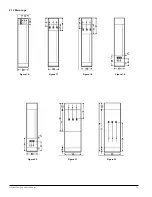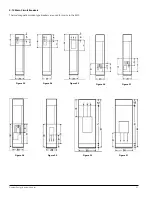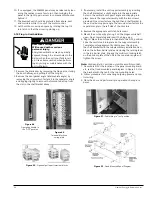
Hazardous voltage.
Will cause death or serious personal inju-
ry.
1) Disconnect and lock-out incoming power
and control voltage sources before beginning
work on this or any other electrical equip-
ment.
2) Check all power and control circuit termi-
nals with a voltmeter to make certain that the
equipment is totally deenergized.
3) Ensure that only Qualified Personnel be
instructed and authorized to use the defeater
mechanism to gain access to an
energized compartment.
4) Never attempt to withdraw a drawout unit
or disconnect any terminations when the
defeater mechanism has been used to open
the compartment door.
It is recommended that a safety ground be connected to the
power bus after the system has been de-energized, and prior
to working on the equipment. Follow the procedure outlined
in the
Pre-Energization Check
section of this manual before
power is restored.
For the safety of maintenance personnel as well as others who
might be exposed to hazards associated with maintenance
activities, the safety related work practices of NFPA 70E, part
11, should always be followed when working on electrical
equipment. Maintenance personnel should be trained in the
safety practices, procedures, and requirements that pertain to
their respective job assignments. This manual should be
reviewed and retained in a location readily accessible for refer-
ence during maintenance of this equipment.
The customer must establish a periodic maintenance program
to ensure trouble-free and safe operation. The frequency of
inspection, periodic cleaning, and preventive maintenance
schedule will depend upon the operation conditions. NFPA
Publication 70B, .Electrical Equipment Maintenance. may be
used as a guide to establish such a program. A preventive
maintenance program is not intended to cover reconditioning
or major repair, but should be designed to reveal, if possible,
the need for such actions in time to prevent malfunctions dur-
ing operation.
The following items should be included in any maintenance
checklist. For more details read the succeeding pages.
• General Inspection of the MCC
• Periodic Cleaning
• Tightening Torques
• Stab Fingers and Vertical Bus
• Circuit Breaker/Disconnect Operator
• Mechanical Interlocks
A specific checklist of routine preventive maintenance require-
ments is recommended for each item of equipment, as well as
a log book to record the maintenance history.
5.2 General Inspection of the MCC
1. Carefully inspect the doors, enclosure sides, and deadfront
surfaces over all units for excessive heat. As a general rule,
a temperature which the palm of the hand cannot stand for
about 3 seconds may indicate trouble. Infra-red heat detec-
tors are available for the purpose of detecting heat
problems.
2. Inspect the motor control center a minimum of once each
year, or more often as deemed necessary. Look for any
moisture or signs of previous wetness or dripping inside the
MCC. Look for any accumulation of dust or dirt. Clean as
explained in the Periodic Cleaning section.
3. Loose electrical connections can cause overheating that can
lead to equipment malfunction or failure. Loose bonding or
grounding can compromise safety and/or function. Terminal
screws, lugs, bus connections, bonding and grounding
connections should be inspected for tightness and
retightened securely as required. Recommended tightening
torques are shown in the Recommended Tightening Torque
section of this manual. Fuse clips should be checked for
signs of overheating, looseness, or inadequate spring pres
sure, and replaced if necessary. All terminals, connections,
and conductors should be examined for evidence of over
heating, corrosion, or pitting. Any parts found to be dam
aged should be replaced, using parts supplied or recom-
mended by Siemens. Evidence of overheating may include
discolored conductors, terminals, or parts; or melted,
charred, or burned insulation.
4. Examine insulation on conductors for overheating or
chafing against metal edges that could progress into an
insulation failure. Any damaged conductors should be
replaced. Replacement conductors should be rerouted,
braced, or shielded if needed to avoid similar damage in
future operation. Temporary wiring should be removed or
replaced by permanent wiring.
Siemens Energy & Automation, Inc.
32













































